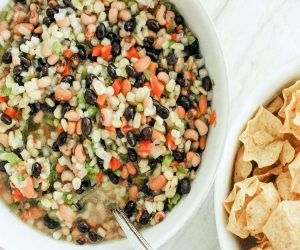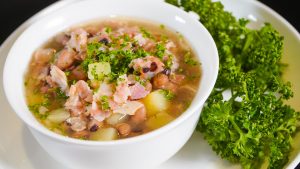This Senegalese black-eyed pea salad is a flavorful, refreshing and healthy dish, taking inspiration from the vibrant cuisine of Senegal. It's a delightful mix of black-eyed peas, vibrant veggies, and a tangy lime dressing, making it a perfect side dish or a light main course.
Some ingredients like black-eyed peas and serrano peppers may not be commonly found in every home. Black-eyed peas, a staple in African and Southern US cuisines, can be found in the canned bean aisle or dried beans section of your supermarket. Serrano peppers, slightly hotter than jalapenos, are usually found in the produce section. If unavailable, jalapenos make a good substitute.
Ingredients for Senegalese Black-Eyed Pea Salad
Lime juice: Provides the tanginess in the dressing.
Parsley: Adds a fresh, herbaceous element.
Olive oil: Used to create the dressing and provides a rich flavor.
Black-eyed peas: The main ingredient, providing protein and texture.
Scallions: Adds a mild onion flavor.
Red bell pepper: Provides a sweet crunch.
Cherry tomatoes: Adds freshness and a pop of color.
Cucumber: Adds a refreshing crunch.
Serrano peppers: Adds a bit of heat.
Sea salt and black pepper: Used for seasoning.
Brown basmati rice: Serves as a base if making this salad a main dish.
Avocado: Adds creaminess and healthy fats.
One reader, Elyn Stephan says:





This Senegalese black-eyed pea salad recipe is a game-changer! The blend of flavors is incredible, and the dressing is so refreshing. It's a perfect balance of tangy and savory. Plus, it's versatile - I've had it as a side dish and as a main meal with rice. Highly recommend!
Techniques Required for Senegalese Black-Eyed Pea Salad Recipe
How to prepare the dressing: Whisk together the lime juice and parsley in a large bowl, then slowly drizzle in the olive oil to make a smooth dressing.
How to marinate the salad: Cover the salad and set it aside at room temperature for at least 1 hour, or refrigerate it for up to overnight to allow the flavors to meld and marinate.
How to serve the salad: Serve the salad chilled or at room temperature. To make it a main dish, serve it on top of cooked brown basmati rice and top with avocado slices.
How To Make Senegalese Black-Eyed Pea Salad
Toss a tasty side with this black-eyed pea salad, made with tomatoes, cucumber, and bell peppers, dressed in a blend of lemon juice, olive oil, and parsley.
Serves:
Ingredients
- ¼cupfresh lime juice,about 2½ limes
- 1cupparsley,chopped
- ½cupolive oil
- 5cupsblack-eyed peas,cooked, roughly 3 cups dried peas make 5 cups cooked
- 10scallions,roughly chopped
- 1redbell pepper,stemmed, seeded, and finely chopped
- 1cupcherry tomatoes,or grape tomatoes, chopped
- 1medium cucumber,seeded and finely chopped
- 2serrano peppers,or 1 habanero or Scotch bonnet chile, stemmed, seeded, and minced
- sea salt and freshly ground black pepper,to taste
- brown basmati rice,cooked, optional
- avocado,sliced, optional
Instructions
-
In a large bowl, whisk together the lime juice and parsley. Continue whisking as you slowly drizzle in the olive oil to make a smooth dressing.
-
Add the black-eyed peas, scallions, bell pepper, tomato, cucumber, and minced pepper to the bowl. Be careful not to transfer tomato juice and seeds to the salad.
-
Season the mixture with salt and pepper and use a big spoon to toss the salad.
-
Cover and set aside at room temperature for at least 1 hour, or refrigerate up to overnight to marinate and meld the flavors.
-
Serve chilled or at room temperature. To make this salad a main dish, serve it on top of cooked brown basmati rice and top with avocado slices.
Nutrition
- Calories: 302.11kcal
- Fat: 18.75g
- Saturated Fat: 2.66g
- Monounsaturated Fat: 13.23g
- Polyunsaturated Fat: 2.17g
- Carbohydrates: 30.52g
- Fiber: 8.31g
- Sugar: 6.81g
- Protein: 5.20g
- Sodium: 641.31mg
- Calcium: 200.61mg
- Potassium: 844.23mg
- Iron: 2.81mg
- Vitamin A: 150.91µg
- Vitamin C: 55.40mg
Technique Tip for Senegalese Black-Eyed Pea Salad Recipe
When preparing the black-eyed peas, it's important to rinse them thoroughly under cold water before adding them to the salad. This not only removes any residual dirt or dust, but also helps to reduce the amount of gas-producing compounds, making the peas easier to digest. Additionally, when chopping the scallions, use both the green and white parts for a more complex flavor profile. The white part has a more intense onion flavor, while the green part is milder and slightly sweet.
Time-Saving Tips for Making This Salad Recipe
Prep ahead: Chop and prepare ingredients in advance to streamline the cooking process.
One-pot wonders: Opt for recipes that allow you to cook everything in a single pot or pan for easy cleanup.
Use kitchen tools: Utilize tools like food processors and mandolines to speed up prep work.
Follow the recipe: Stick to the recipe to avoid mistakes and save time on improvisation.
Organize your workspace: Keep your kitchen tidy and organized to minimize time spent searching for ingredients and tools.
Cook in batches: Prepare large quantities of food and freeze individual portions for quick and convenient meals later on.
Substitute Ingredients For Senegalese Black-Eyed Pea Salad Recipe
fresh lime juice - Substitute with lemon juice: Lemon juice can provide a similar level of acidity and brightness to the dish.
parsley - Substitute with cilantro: Cilantro can offer a fresh and vibrant flavor similar to parsley.
olive oil - Substitute with avocado oil: Avocado oil has a mild flavor and high smoke point, making it a suitable alternative for dressing.
black-eyed peas - Substitute with cannellini beans: Cannellini beans have a creamy texture and mild flavor that can work well in the salad.
scallions - Substitute with shallots: Shallots can provide a milder onion flavor and a touch of sweetness to the salad.
red bell pepper - Substitute with yellow bell pepper: Yellow bell pepper can offer a similar crunch and sweetness to the dish.
cherry tomatoes - Substitute with grape tomatoes: Grape tomatoes are small and sweet, making them a suitable replacement for cherry tomatoes.
cucumber - Substitute with zucchini: Zucchini can provide a similar crisp texture and mild flavor to the salad.
serrano peppers - Substitute with jalapeño peppers: Jalapeño peppers can offer a similar level of heat and flavor to the dish.
sea salt and freshly ground black pepper - Substitute with kosher salt and ground white pepper: These alternatives can provide a similar level of seasoning with a slightly different flavor profile.
brown basmati rice - Substitute with quinoa: Quinoa can offer a nutty flavor and similar texture to brown basmati rice.
avocado - Substitute with mango: Mango can provide a sweet and creamy element to the salad, similar to avocado.
Best Way to Present Senegalese Black-Eyed Pea Salad
Elevate the plating: When presenting the Senegalese black-eyed pea salad, focus on creating an elegant and visually appealing presentation. Use a large, white, or earth-toned plate to provide a clean canvas for the vibrant colors of the salad to pop.
Incorporate texture: Add a touch of sophistication by incorporating different textures. Consider using a sleek, modern serving dish to contrast the rustic nature of the salad, creating a visually stimulating experience for the diners.
Garnish with precision: Carefully garnish the dish with freshly sliced avocado arranged in a fan shape on top of the salad. This adds a touch of finesse and a creamy element that complements the flavors of the dish.
Emphasize balance: Arrange the salad in a way that showcases the balance of ingredients. Place the cherry tomatoes and cucumber slices strategically to create a harmonious visual balance, demonstrating attention to detail and culinary expertise.
Highlight the colors: Ensure that the vibrant colors of the salad are showcased by arranging the ingredients thoughtfully. The red bell pepper, green cucumber, and black-eyed peas should be visually striking and well-distributed throughout the plate.
Use minimalism: Embrace the concept of minimalism by allowing the natural beauty of the ingredients to shine through. Avoid overcrowding the plate and let the simplicity of the dish speak for itself.
Focus on precision: Pay attention to the placement of each component, ensuring that every element is meticulously positioned to create a visually stunning and appetizing presentation.
Create a focal point: Consider creating a focal point by arranging the salad in a circular or asymmetrical pattern, drawing the eye to the center of the plate and creating an engaging visual experience for the diners.
Essential Tools for Making Black-Eyed Pea Salad
- Cutting board: A flat, sturdy surface used for cutting and preparing ingredients.
- Chef's knife: A versatile, all-purpose knife used for chopping, slicing, and dicing.
- Mixing bowl: Used for combining ingredients and mixing dressings or marinades.
- Whisk: A kitchen tool used for blending ingredients together and incorporating air into mixtures.
- Large spoon: Used for stirring, mixing, and serving dishes.
- Strainer: Used for draining and rinsing ingredients such as beans or vegetables.
- Food processor: A versatile appliance used for chopping, pureeing, and blending ingredients.
- Citrus juicer: Used for extracting juice from citrus fruits such as limes for dressings and marinades.
- Measuring cups and spoons: Essential for accurately measuring ingredients for recipes.
- Knife: Used for precise cutting and slicing of ingredients.
- Peeler: Used for peeling vegetables and fruits.
- Serving platter: Used for presenting and serving the salad.
How to Store and Freeze Senegalese Black-Eyed Pea Salad
Here are the storing and freezing guidelines for Senegalese black-eyed pea salad:
- Refrigerate the salad in an airtight container for up to 4 days. The flavors will continue to meld and improve over time.
- If you plan to store the salad for longer than 4 days, it's best to keep the dressing separate from the salad ingredients. Store the dressing in a separate airtight container in the refrigerator for up to 1 week. When ready to serve, toss the salad with the dressing.
- To freeze the salad, transfer it to a freezer-safe container or resealable plastic bag. Squeeze out as much air as possible before sealing. Freeze for up to 3 months. However, keep in mind that the texture of the vegetables may change slightly after freezing and thawing.
- When ready to serve the frozen salad, thaw it in the refrigerator overnight. If the salad seems dry after thawing, you can toss it with a little extra olive oil and lime juice to refresh the flavors.
- If you plan to freeze the salad, it's best to omit the avocado and add it fresh when serving. Frozen and thawed avocado can become mushy and unappealing.
- Leftover salad can be enjoyed cold or at room temperature. If you prefer to serve it warm, gently reheat it in the microwave or on the stovetop over low heat until just warmed through. Be careful not to overcook the vegetables, as they may become mushy.
How to Reheat Leftover Black-Eyed Pea Salad
To reheat leftover Senegalese black-eyed pea salad, start by removing it from the refrigerator and letting it sit at room temperature for about 30 minutes. This will help the flavors come back to life and prevent the salad from being too cold when you eat it.
If you prefer your salad slightly warm, you can place it in a microwave-safe bowl and heat it on high for 30-45 seconds, stirring halfway through. Be careful not to overheat the salad, as this can cause the vegetables to become mushy and the dressing to separate.
Another option is to reheat the salad in a skillet over medium-low heat. Add a small amount of olive oil to the pan and stir the salad gently until it's heated through, about 3-5 minutes. This method will help the flavors meld together and give the salad a slightly caramelized taste.
If you're planning to serve the salad over brown basmati rice, you can reheat the rice separately in the microwave or on the stovetop. To microwave, place the rice in a microwave-safe bowl, cover it with a damp paper towel, and heat on high for 1-2 minutes, stirring halfway through. To reheat on the stovetop, place the rice in a saucepan with a splash of water, cover, and heat over medium-low heat until steaming, about 5 minutes.
When you're ready to serve, spoon the warm rice into bowls and top with the reheated black-eyed pea salad. Finish with fresh avocado slices and a sprinkle of salt and pepper to taste. Enjoy your delicious and healthy meal!
Random Fact About Senegalese Black-Eyed Pea Salad
The Senegalese black-eyed pea salad is a nutritious dish that is rich in plant-based protein, fiber, and essential nutrients. Black-eyed peas, also known as cowpeas, are a good source of folate, iron, and potassium. This salad is a great option for those following a vegetarian or vegan diet, as it provides a complete protein when paired with brown basmati rice. Additionally, the combination of lime juice, parsley, and serrano peppers adds a refreshing and zesty flavor to the dish, making it a perfect choice for a light and satisfying meal.
Is Making Black-Eyed Pea Salad Economical for Home Cooking?
This Senegalese black-eyed pea salad recipe is highly cost-effective for a household. The main ingredients, such as black-eyed peas, vegetables, and olive oil, are budget-friendly and readily available. The versatility of the dish allows for variations based on seasonal produce, making it even more economical. The overall verdict rating for this recipe is 9/10, considering its nutritional value, flavor, and affordability. The approximate cost for a household of 4 people is around $15, making it an excellent choice for a budget-friendly and nutritious meal.
Is This Black-Eyed Pea Salad Healthy or Unhealthy?
This Senegalese black-eyed pea salad recipe is a nutritious and well-balanced dish. The black-eyed peas provide a good source of plant-based protein, fiber, and various vitamins and minerals. The vegetables, such as bell pepper, tomatoes, and cucumber, offer additional fiber, vitamins, and antioxidants. The olive oil in the dressing is a healthy source of monounsaturated fats, which can help reduce inflammation and improve heart health. The lime juice and parsley add a burst of flavor and provide vitamin C and other beneficial compounds. Serving the salad over brown basmati rice further enhances the nutritional value by adding complex carbohydrates and additional fiber.
To make this recipe even healthier, consider the following suggestions:
- Reduce the amount of olive oil in the dressing to lower the overall calorie content. You can replace some of the oil with additional lime juice or a bit of water to maintain the desired consistency.
- Include a variety of colorful vegetables to increase the diversity of nutrients. Consider adding shredded carrots, diced beets, or chopped spinach to the salad.
- Opt for low-sodium or no-salt-added black-eyed peas to reduce the sodium content of the dish. If using canned peas, rinse them thoroughly before adding them to the salad.
- Experiment with different herbs and spices to enhance the flavor without relying on excessive salt. Try adding fresh cilantro, mint, or a pinch of cumin or paprika to the dressing.
Editor's Thoughts on Senegalese Black-Eyed Pea Salad Recipe
This Senegalese black-eyed pea salad recipe is a delightful fusion of flavors and textures. The zesty lime dressing complements the earthy black-eyed peas, while the fresh vegetables add a burst of color and crunch. The hint of heat from the serrano peppers adds a tantalizing kick. Allowing the salad to marinate enhances the depth of flavors, making it a perfect make-ahead dish. Serving it over brown basmati rice and topping it with creamy avocado slices elevates it to a satisfying main course. This recipe is a vibrant and nutritious addition to any meal.
Enhance Your Senegalese Black-Eyed Pea Salad Recipe with These Unique Side Dishes:
Alternative Recipes Similar to Senegalese Black-Eyed Pea Salad
Suggested Appetizers and Desserts to Serve With Black-Eyed Pea Salad
Why trust this Senegalese Black-Eyed Pea Salad Recipe:
This recipe is a delightful fusion of flavors and textures, featuring the wholesome goodness of black-eyed peas and the zesty freshness of lime juice. The combination of vibrant parsley and rich olive oil creates a luscious dressing that infuses every bite with a burst of flavor. With the addition of scallions, bell pepper, cherry tomatoes, and cucumber, this salad is a colorful medley of nutritious ingredients. The subtle heat from serrano peppers adds a tantalizing kick. This recipe promises a delightful experience, perfect for any occasion.
Was this page helpful?
Have your own special recipe to share? Submit Your Recipe Today!













